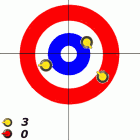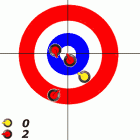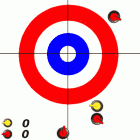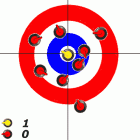curling
Curling(冰壶)
The History of Curling
Curling is a very old scottish(苏格兰)sport. It isn't known, when scottish people began playing Curling. But in the Smith Institute in Stirling(斯特灵,英国苏格兰中部城市,中央区州府) is a rock with the engraved year 1511 exposed. The first report about a Curling match between two monks(修道士) stems from Paisley Abbey(大修道院) near Glasgow(格拉斯哥,英国城市) and is dated February 1541. Someone named Mr. James Gall let on his tombstone engrave in Perth, Scotland, that he was a big Curling fan.
The ancient Scotland was a poor country. The Citys hadn't got a lot citizens, no public traffic existed, the land was poor and only within some months useful. So, the only occupation of the Scots was to thrash the British or steal some sheeps of the neighbor's clan(部落). But at all times, they did sports. The hooligans(流氓阿飞) were probably a scottish invention, because 1457, the scottish parliament(国会) prohibitted Soccer and Golf because they aroused riots(暴乱). Curling wasn't endangered by this prohibition although the rocks were great to hit an opponent..
The first Curling rocks weighted only 2 or 3 kg. They had the design of a hand. And so they were called "loofies" (loof=hand in old english) With the help of the time, the rocks became like today ones. The people called them boulders, gave them a handle and rounded them like the modern rocks . At the beginning, everybody knew, that you must shoo the rockk from A to B, but no precise rules were known. Especially the lenght or width of the rink or the size and the weight of the rock were unknown.. That's why some real boulders appeared in 18th Century. The biggest one, the "Jubilee Stone" had the weight of 58.5 kg. If this would be still so today, Curling would be a sport for strong men. Fortunately, the evolution took another way.
The curlers took the "Round Stones" with the weight of approximate 20 kg, but the first stone wich had the today usual hollow grinding was used in 1784 by Mr. Tam Pate. With this hollow grind, he was able to play a twist around a guard. Today we call this curl. Through this late invention, we know, that the word Curling isn't based on the verb to curl, but comes from the old verb to curr (to grumble)
The first Curling club was founded in Kinross, Loch Leven in 1668. The first national association was the Grand Caledonian Curling Club (founded in 1838). In 1843, the club got the privilege to be the Royal Caledonian Curling Club. This Club was the World Federation, till 1966, when the ICF (International Curling Federation) was founded. Since 1991 the ICF is called WCF (World Curling Federation).
Women are today a matter of course. In example, the German Curling Federation wouldn't be so successful when it wouldn't have women. The first women's Curling club was founded in 1895 and had the name "Hercules". Women got their own world championship in 1979, 20 years after the men.
Rules of The Curling
About Team
A team consists of 4 players. The Lead, the Second, the Third or the Vice-Skip and the Skip. Every curler plays 2 stones per End. During the End the Skip is standing in the house and controls the game. He gives tactical tips (if the curlers should play offensive or defensive...) and "gives ice" for the stonedelivery (look under "game"). If the Skip plays his 2 stones the Third stands in the house.
Finish of the game
You win the game when you scored often. A normal play is divided up in 10 Ends. One End lasts about 15 minutes. Per End only one team kann score (compare "points").
Points
Per End only one team can score. Only this stones can be counted that are in the house (or touch the edge of the house). A team receives a piont for every stone that is nearer the center than any other stone from the opponent team (look at pictures). The two Skips decide this only with the help of their eyes. If they can not distinguish wich stone is nearer the house they can use a measuring device. If also the measuring device does not bring a decide nobody receives a piont.
Sweeping
A team can sweep its stones between the two Tee-Lines. Stones that are standing still and were transfered into moving due another stone can also be sweeped. Presweeping is not allowed. Behind the distant Tee-Line only the Skips are allowed to sweep the stones. But they can sweep all stones (also the opponent stones). When the curlers are sweeping or doing other activites no stone is to be touched. If a team touches a still standing stone it will be transfered back to the origin position. But if a team touches an own moving stone that was just played it will be removed of the game and all other stones that were touched from this stone will be replaced to the origin position.
Free Guard Zone
Free Guard Zone means all space between hog and teeline except the house. There are two kinds of the Free Guard Zone rule (FGZ-rule): the European or 4-Rock-FGZ-rule and the Canadian or 3-Rock-FGZ-rule. In the European version the first four stones of an End that are in the FGZ (look at the picture) must not be kicked out of the game. In the Canadian version this rule count only for the first three stones of the End. This rule keeps the game more interesting because that team wich has the right of the last stone is not allowed to kick out all opponent stones.
Spirit of Curling
In Curling, there two different types of rules. The official ones and the "Spirit of Curling". The Spirit of Curling contains rules such as, "Always be polite to your opponent" or "The loser congratuates the winner, while the winner thanks the loser for the game". It is even bader to offend against the Spirit of Curling as offend against the official rules.
附件列表
词条内容仅供参考,如果您需要解决具体问题
(尤其在法律、医学等领域),建议您咨询相关领域专业人士。




